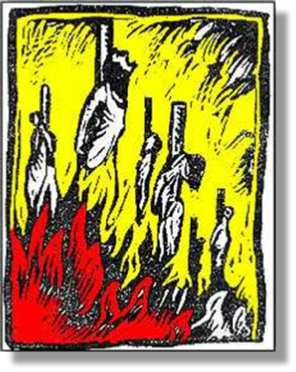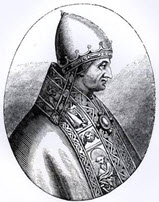


THE INQUISITION 1231 (H3)
xxxxxThe Inquisition, a church court, was used to seek out the “enemies of society”, such as the heretic, the alchemist and the witch. There was a wide range of punishments, culminating in death by burning. It was established by Pope Gregory IX in 1231 to deal with the Albigenses in southern France, but later it was at work throughout Europe and the New World, especially after the Spanish Inquisition, set up in 1478 (E4), and the emergence of Protestantism in the following century. By this time much of its work had been entrusted to the Dominican and Franciscan friars. Torture to extract confessions was not used until authorised by pope Innocent IV in 1252, justified by a verse in Luke's Gospel containing the word “constrain them to come in”.
 xxxxxThe church court known as the Inquisition was established to combat heresy and, later, such activities as alchemy and witchcraft. As its name implies (it comes from the Latin meaning “inquire into”), its job was not simply to deal with reported cases, but also to seek out these “enemies of society” and punish them for their misdeeds. The penalties inflicted ranged from fasting, fines and public floggings to confiscation of property and life imprisonment. In severe cases -
xxxxxThe church court known as the Inquisition was established to combat heresy and, later, such activities as alchemy and witchcraft. As its name implies (it comes from the Latin meaning “inquire into”), its job was not simply to deal with reported cases, but also to seek out these “enemies of society” and punish them for their misdeeds. The penalties inflicted ranged from fasting, fines and public floggings to confiscation of property and life imprisonment. In severe cases -
xxxxxThe need for such a court, established by Pope Gregory IX in 1231, arose from the emergence of large-
xxxxxDuring its early years, the Inquisition was mostly limited to northern Europe, northern Italy and southern France, but, as we shall see, it became more widely used with the setting up of the Spanish Inquisition in 1478 (E4). By that time much of its work had been entrusted to the Dominican and Franciscan Orders of Friars. Later the Roman Inquisition was established to combat the growth of Protestantism, and the work of the Inquisition was extended into the Americas.

xxxxxIncidentally, Pope Innocent IV, the pope who in 1252 authorised the use of torture to obtain confessions, based his action on a verse in the Gospels which, he claimed, had been endorsed by no other than the church father Saint Augustine. The verse reads: And the lord said unto the servant, Go out into the highways and hedges and constrain them to come in, that my house may be filled. (Luke 14, verse 23). We might feel today that the weight of his argument rested on rather thin ice!
H3-
Acknowledgements
Auto-


